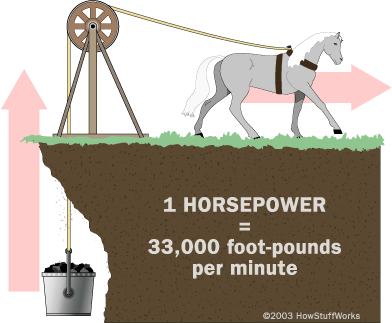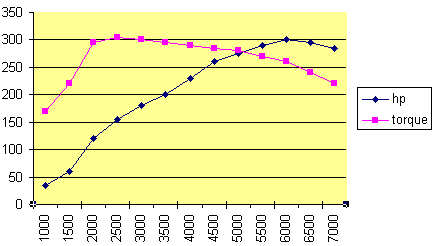How Horsepower Works
Chances are you've heard about horsepower. Just about every car ad on TV mentions it, people talking about their cars bandy the word about and even most lawn mowers have a big sticker on them to tell you how much horsepower the engine has.
But what is horsepower, and how much horsepower does a horse have? What does the horsepower rating mean in terms of power output, and why are car enthusiasts obsessed with horsepower? Here, you'll learn exactly what horsepower is and how you can apply it to your everyday life.
Horsepower Originated With the Steam Engine
The term horsepower was invented by the engineer James Watt. Watt lived from 1736 to 1819 and is most famous for his work on improving the power output of steam engines. We are also reminded of him every day when we talk about 60-watt light bulbs.
How Much Horsepower Does a Horse Have?
In short, 1 horsepower is equal to 33,000 foot-pounds per minute. The story goes that Watt was working with ponies lifting coal at a coal mine, and he wanted a way to talk about the power available from one of these animals.
He found that, on average, a draft horse could do 22,000 foot-pounds of work in a minute. He then increased that number by 50 percent and pegged the measurement of one horsepower at 33,000 foot-pounds of work in one minute.

It is that arbitrary unit of measure that has made its way down through the centuries from steam engines and now appears on your car, your lawn mower, your chain saw and even in some cases your vacuum cleaner.
Although the steam engine is no longer relevant, all other engines and motors are subject to the same laws of physics, and that makes horsepower handy as a measurement standard.
So, imagine a draft horse raising coal out of a coal mine as shown in this illustration. An average horse exerting one horsepower can theoretically raise 33,000 pounds of coal one foot in a minute, or 33 pounds of coal 1,000 feet in one minute, or 1,000 pounds 33 feet in one minute.
Horsepower can be converted into other units as well. For example:
1 horsepower is equivalent to 746 watts. So if you took a 1-horsepower horse and put it on a treadmill, it could operate a generator producing a continuous 746 watts.
1 horsepower (over the course of an hour) is equivalent to 2,545 BTU (British thermal units). If you took that 746 watts and ran it through an electric heater for an hour, it would produce 2,545 BTU (where a BTU is the amount of energy needed to raise the temperature of 1 pound of water 1 degree F).
One BTU is equal to 1,055 joules, or 252 gram-calories or 0.252 food calories. Presumably, a horse producing 1 horsepower would burn 641 Calories in one hour if it were 100 percent efficient.
Some countries use a similar but distinct unit of power measurement known as the metric horsepower. This unit is officially defined as the amount of power it takes to raise a 75-kilogram mass one meter upwards in one second, and one metric horsepower is roughly equal to 98.6 percent of a standard horsepower unit.
Measuring Horsepower
To find how much power an engine makes, you hook the engine up to a dynamometer. A dynamometer places a load on the engine and measures the amount of power that the engine can produce against the load.
You can get an idea of how a dynamometer works in the following way: Imagine that you turn on a car engine, put it in neutral and floor it. The engine would run so fast it would explode. That's no good, so on a dynamometer you apply a load to the floored engine and measure the load the engine can handle at different engine speeds.
You might hook an engine to a dynamometer, floor it and use the dynamometer to apply enough of a load to the engine to keep it at, say, 7,000 rpm. You record how much load the engine can handle. Then you apply additional load to knock the engine speed down to 6,500 rpm and record the load there. Then you apply additional load to get it down to 6,000 rpm, and so on.
You can do the same thing starting down at 500 or 1,000 rpm and working your way up, giving you an impression of total engine output. What dynamometers actually measure is torque (in pound-feet), and to convert torque to horsepower you simply multiply torque by rpm/5,252.
Graphing Horsepower
If you plot the average horsepower versus the rpm values for the engine, what you end up with is a horsepower curve for the engine. A typical horsepower curve for a high-performance engine might look like this (this happens to be the curve for the 300-horsepower engine in the Mitsubishi 3000 twin-turbo):

What a graph like this points out is that any engine has a peak horsepower — an rpm value at which the power available from the engine is at its maximum output. An engine also has a peak torque at a specific rpm.
You will often see this expressed in a brochure or a review in a magazine as "320 HP @ 6500 rpm, 290 lb-ft torque @ 5000 rpm" (the figures for the 1999 Shelby Series 1). When people say an engine has "lots of low-end torque," what they mean is that the peak torque occurs at a fairly low rpm value, like 2,000 or 3,000 rpm.
Another thing you can see from a car's horsepower curve is the place where the engine has maximum power. When you are trying to accelerate quickly, you want to try to keep the engine close to its maximum horsepower point on the curve.
That is why you often downshift to accelerate: By downshifting, you increase engine rpm, which typically moves you closer to the peak horsepower point on the curve.
Torque
Imagine that you have a big socket wrench with a 2-foot-long handle on it, and you apply 50 pounds of force to that 2-foot handle. What you are doing is applying a torque, or turning force, of 100 pound-feet (50 pounds to a 2-foot-long handle) to the bolt.
You could get the same 100 pound-feet of torque by applying 1 pound of force to the end of a 100-foot handle or 100 pounds of force to a 1-foot handle.
From Steam Engines to High-performance Cars
A car is considered to be "high performance" if it has a lot of power relative to the weight of the car, which makes sense. The more weight you have, the more power it takes to accelerate it. For a given amount of power you want to minimize the weight in order to maximize the acceleration.
The following table shows you the horsepower and weight for several high-performance cars (and one low-performance car for comparison). In the chart you can see the peak horsepower, the weight of the car, the power-to-weight ratio (horsepower divided by the weight), the number of seconds the car takes to accelerate from zero to 60 mph, and the price.
Horsepower | Weight (lbs) | Power:Weight | 0 to 60 mph (seconds) | |
Dodge Viper | 450 | 3,320 | 0.136 | 4.1 |
Ferrari 355 F1 | 375 | 2,975 | 0.126 | 4.6 |
Shelby Series 1 | 320 | 2,650 | 0.121 | 4.4 |
Lotus Esprit V8 | 350 | 3,045 | 0.115 | 4.4 |
Chevrolet Corvette | 345 | 3.245 | 0.106 | 4.8 |
Porsche Carrera | 300 | 2,900 | 0.103 | 5.0 |
Mitsubishi 3000GT twin-turbo | 320 | 3,740 | 0.086 | 5.8 |
Ford Escort | 110 | 2,470 | 0.045 | 10.9 |
You can see a very definite correlation between the power-to-weight ratio and the 0-to-60 mph time; in most cases, a higher ratio indicates a quicker car. If you want a fast car, you want a good power-to-weight ratio, meaning you want lots of power and minimal weight. So the first place to start is cleaning out your trunk.
Original article: How Horsepower Works
Copyright © 2024 HowStuffWorks, a division of InfoSpace Holdings, LLC, a System1 Company

